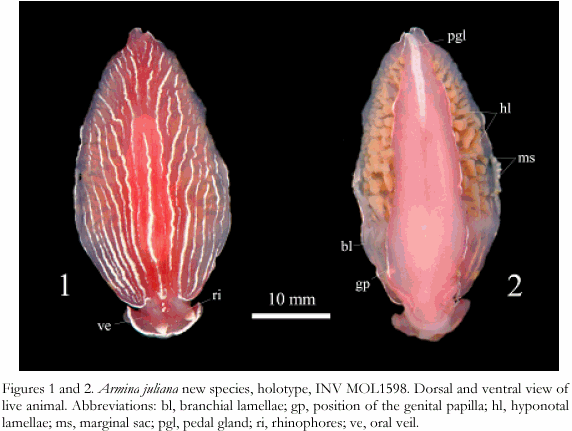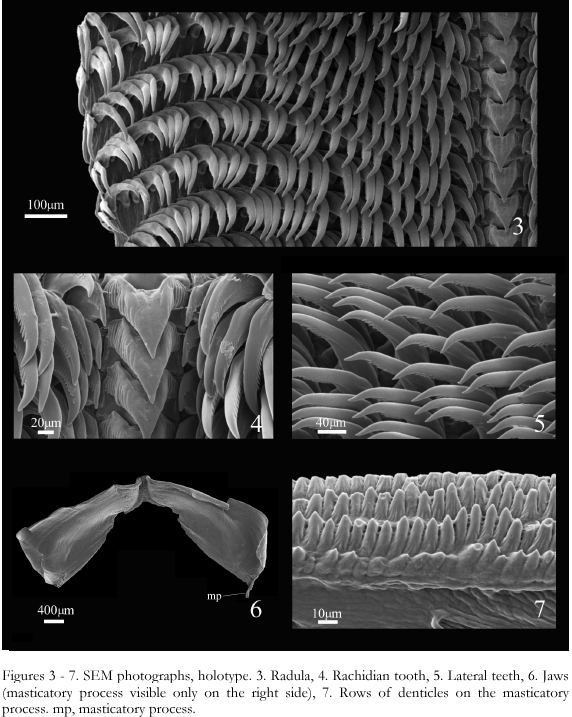Services on Demand
Journal
Article
Indicators
-
 Cited by SciELO
Cited by SciELO -
 Access statistics
Access statistics
Related links
-
 Cited by Google
Cited by Google -
 Similars in
SciELO
Similars in
SciELO -
 Similars in Google
Similars in Google
Share
Boletín de Investigaciones Marinas y Costeras - INVEMAR
Print version ISSN 0122-9761
Bol. Invest. Mar. Cost. vol.31 no.1 Santa Marta Jan./Dec. 2002
ARMINA JULIANA (GASTROPODA: NUDIBRANCHIA: ARMINIDAE), A NEW SPECIES FROM THE SOUTHERN CARIBBEAN
ARMINA JULIANA (GASTROPODA: NUDIBRANCHIA: ARMINIDAE), UNA ESPECIE NUEVA DEL CARIBE SUR
Néstor E. Ardila E. and Juan Manuel Díaz
Instituto de Investigaciones Marinas y Costeras - INVEMAR -, A.A. 1016, Santa Marta, Colombia. E-mail: nardila@invemar.org.co and jmdiaz@invemar.org.co.
ABSTRACT
A new species of the genus Armina,collected off the northern Caribbean coast of Colombia at depths of 310 and 460 m in soft bottoms is described. The number of notal ridges, the position of the genital papilla, the size and the shape of radular teeth and the features of the masticatory process are the main differences to other congeneric species occurring in Atlantic waters. Armina juliana n. sp. is the first record for the family Arminidae in the Colombian Caribbean.
KEY WORDS: Nudibranchia, Arminidae, Armina, new species, Caribbean Sea, Colombia.
RESUMEN
Se describe una especie nueva del género Armina, colectada frente a la costa septentrional del Caribe colombiano, en fondos blandos, a profundidades de 310 y 460 m. El número de crestas notales, la posición de la papila genital, el tamaño y la forma de los dientes radulares y las características de los procesos masticatorios son las principales diferencias con otras especies congéneres presentes en el Atlántico. Armina juliana especie nueva, es el primer registro de la familia Arminidae en el Caribe colombiano.
PALABRAS CLAVE: Nudibranchia, Arminidae, Armina, especie nueva, Mar Caribe, Colombia.
INTRODUCTION
The Arminidae constitutes a poorly known group of nudibranchs occurring mainly in deep waters, of which about 75 species in six nominal genera have been described (see Kolb and Wägele, 1998). The arminids have an elongated, flattened body narrowing posteriorly, with longitudinal ridges or pustules on the notum, the latter bearing marginal sacs along its marginal edge; they have a distinct oral veil and retractile rhinophores with a caruncle in front of them; the radula typically has a broad, denticulated rachidian tooth, and the lateral teeth are falciform (see Kolb, 1998). However, except for the caruncle and the subnotal lamellae, which are typical for some but not all genera, all these characters are plesiomorphic, and no autapomorphies have yet been recognized for Armina (Kolb, 1998; Kolb and Wägele, 1998). The majority of species in all other genera than Armina (Dermatobranchus, Histiomena, Linguella, Pleurophyllidella and Pleurophyllidiopsis) are geographically restricted to distinct areas in the Indo-Pacific realm. Hence, it is supposed that arminids probably originated in the western Pacific and have distributed in a westerly direction (Kolb and Wägele, 1998).
Armina is the species-richest genus of the family, with more than 50 nominal species, and includes the more derived forms of the group (Kolb and Wägele, 1998). Features shared by members of this genus are the continuous anterior mantle margin, the presence of branchial and hyponotal lamellae, and the close distance between the rhinophores. Although Armina exhibits a world-wide distribution, only four specieshave been recorded in the western Atlantic to date (see Marcus and Marcus, 1960; 1967; Kolb and Wägele, 1998). This paper describes a new species of Armina collected off the northern Caribbean coast of Colombia.METHODS
Two specimens of the new species were collected using a bottom trawl (opening: 9x1 m; length: 16 m) during the second cruise (November 1998) of the INVEMAR-Macrofauna I Expedition aboard the R/V Ancón (belonging and operated by INVEMAR), off the Guajira Peninsula, northern Colombian Caribbean coast, at depths of about 300 and 460m. Specimens were preserved in 70% ethanol. Subsequently, jaw and radula of one specimen (holotype) were examined using a scanning electronic microscope (SEM). The nomenclature of the radula follows Kolb (1998).
RESULTS
Class Gastropoda Cuvier 1797
Subclass Opisthobranchia Milne-Edwards 1848
Order Nudibranchia Cuvier 1817
Family Arminidae Rafinesque 1814
Genus Armina Rafinesque 1814
Armina juliana new species
Type material: Holotype (Figs. 1, 2) deposited in the Reference Collection of the Instituto de Investigaciones Marinas y Costeras, INVEMAR, at Santa Marta, Colombia (INVEMAR-Mol-1598), length 41 mm alive, loc. off Cabo de La Vela, Colombia (12o 19'; N, 72o 42'; W), 460 m, muddy bottom. Paratype, deposited in the Natural History Museum of Los Angeles County, Los Angeles, CA, USA (LACM-2908), length 14 mm alive, loc. off Palomino, Colombia (11o 26'; N, 73o 32'; W), 306-312 m, muddy bottom.
Etymology: The species is named after Juliana Ardila, the daughter of the senior author.
Description: The living animals are bright red in color with contrasting white longitudinal notal ridges; the anterior margin of the oral veil and the apical portion of the rhinophores are also white (Fig. 1). Preserved specimens are pale pink. The body is elongated, flattened, narrowing posteriorly. The notum bears 34 longitudinal dorsal ridges, whose margins do not exhibit any black spots of pigment shimmer. The oral veil is distinct. Two club-shaped rhinophores, each one with about 10 vertical lamellae. Eyes are visible through the epidermis at the outer base of each rhinophore. A caruncle is also distinguishable in front of the rhinophores. The genital opening is located on the right side, anterior to the branchial lamellae. The anal papilla is located slightly behind the midpoint (3/5 of total length, from anterior). Twenty-one branchial lamellae were counted on the right side of the body, nineteen on the left. Fifteen hyponotal lamellae are found on each side of the body. A deep groove is present along the center the foot sole (Fig. 2). The pedal gland is white and located at the posterior end of the foot sole (Fig. 2). Marginal sacs (each about 0.7 mm in diameter) are hardly distinguishable macroscopically on both sides just behind the branchial lamellae (Fig. 2). The radula has the formula 27 X 32.1.1.1.32 (holotype) (Fig. 3). The rachidian tooth is broad (112 µm) and bears 12 elongated denticles on either side of the median cusp (Figs. 3, 4). The first lateral tooth is short, bulky and denticulated on the outer side of the cusp. The remaining lateral teeth are elongated and also bear denticles which become progressively smaller towards the marginal tooth rows (Fig. 5). The jaws have a denticulated masticatory border (Fig. 6), and a long masticatory process (Fig. 7). Each process bears four rows of denticles (Fig. 7).
DISCUSSION
Armina juliana n. sp. can be distinguished from other species occurring in the Atlantic Ocean and neighboring seas by one or more characters. However, the shape of the radular teeth, whose intraspecific variability seems to be small in the arminids (Marcus and Marcus, 1966), is apparently the best character to distinguish the species (Kolb, 1998).
In A. tigrina Rafinesque, 1814 (see Thompson et al., 1990 and Kolb, 1998 for descriptions and figures), the type species of the genus (range: west Africa, Mediterranean Sea, northeastern Atlantic, eastern coast of North America), the notal ground color is black and bears 23 white notal ridges; the number of branchial (> 100/side) and hyponotal (37-42/side) lamellae is greater than in A. juliana (19-21/side, 15/side respectively); the radular formula in A. tigrina is 35 X 56. 1.1.1. 56 and the median cusp of the rachidian tooth is not as broad as in A. juliana and bears very fine denticles. In A. abbotti Thompson et al., 1990 (range: western Atlantic, from North Carolina to Texas), erroneously identified as A. tigrina, the radular rachidian tooth is broader than long with four to five strong lateral cusps on each side of a mono- to tri-denticulate median cusp (see Eyster, 1981). Additionally, the median cusp is not as projected as in the new species.
A. loveni (Bergh, 1866) (northeastern Atlantic; see Kolb, 1998 for description) is pale red-brown in color with 23 light notal ridges (instead of 34 in A. juliana), and black pigment is visible between them. Although the numbers of branchial and hyponotal lamellae in A. juliana fall within the range in A. loveni (9-26/side and 15-25/side respectivelly) and the radular lateral teeth in both species are quite similar, the radular formula (35 X 28.1.1.1.28 in A. loveni) and the rachidian teeth [a less conspicuous median cusp and five (instead of 12) coarse denticles on either side in A. loveni] are crearly different.
A. muelleri (v. Ihering, 1886) (southern Brazil and Florida; see Marcus and Marcus, 1960 for description) has apparently a dark, opaque notum with light yellow or pale reddish ridges, and the radular formula (44 X 51.1.1.1.51) and teeth morphology are very different to them in A. juliana; the median cusp of the rachidian tooth is broader (250 µm) than in A. juliana and bears three to four denticles on either side. A. wattla Marcus, 1967 (off Georgia, USA; see Marcus and Marcus, 1967) exhibits 36 notal ridges, and black pigment is visible between them. The radular formula (40 X 46.1.1.1.46) is different, and the median cusp of the rachidian tooth (with five to seven denticles on either side) is not as projected as in A.juliana. In addition, A. juliana n. sp. can be easily distinguished from all the above mentioned species by the position of the genital papilla, which in the new species is located anterior to the branchial lamellae, whereas in the other species it is located just posterior to the lamellae. A. juliana n. sp. represents the first record of the genus Armina and the family Arminidae in the Caribbean Sea and (after A. tigrina, A. abbotti, A. muelleri and A. wattla, see Kolb and Wägele, 1998), it is the fifth arminid known to occur in western Atlantic waters. Moreover, except for the new species, no other species of Armina has been yet recorded from waters deeper than 200 m in the western Atlantic.
ACKNOWLEDGEMENTS
We would like to thank A. Valdés for calling our attention to the new species. M. G. Harasewych and S. Braden kindly helped with the SEM images at the NMNH in Washington. Y. Villacampa and N. Cruz collaborated with the provision of literature. The personnel and facilities of the reference collection at INVEMAR, Santa Marta, made possible the assembly and improvement of images. We are indebted to A. Kolb, P. Mikkelsen and A. Valdés for the critical review of the manuscript. We thank INVEMAR, COLCIENCIAS (Grant No. 2105-13-079-97) and the Colombian Ministry of the Environment for financial support.
BIBLIOGRAPHY
1 Eyster, L.S. 1981. Observations on the growth, reproduction and feeding of the nudibranch Armina tigrina. J. Moll. Stud., 47:171-181. [ Links ]
2 Kolb, A. 1998. Morphology, anatomy and histology of four species of Armina Rafinesque, 1814 (Nudibranchia, Arminoidea, Arminidae) from the Mediterranean sea and the Atlantic Ocean. J. Moll. Stud., 64: 355-386. [ Links ]
3 __________. and H. Wägele. 1998. On the phylogeny of the Arminidae (Gastropoda, Opisthobranchia, Nudibranchia) with considerations of biogeography. J. Zool. Syst. Evol. Research, 36: 53-64. [ Links ]
4 Marcus, E. and E. Marcus. 1960. Opisthobranchs from American Atlantic warm waters. Bull. Mar. Sci. Gulf Carib., 10(1):129-203. [ Links ]
5 __________. 1966. The R/V Pillsbury deep-sea biological expedition to the Gulf of Guinea, 1964-65. Opisthobranchs from tropical West Africa. Stud. Trop. Oceanogr. Miami, 4: 152-208. [ Links ]
6 __________. 1967. Some opisthobranchs from Sapelo Island, Georgia, USA. Malacologia, 6: 199-222. [ Links ]
7 Thompson, T. E., Cattaneo, R. and Y. M. Wong. 1990. Eastern Mediterranean Opisthobranchia: Dotidae (Dendronotoidea), Arminidae and Madrellidae (Arminoidea). J. Moll. Stud., 56: 393-413. [ Links ]
FECHA DE RECEPCIÓN:Abr 4, 2001 FECHA DE ACEPTACIÓN: May 6, 2002.















